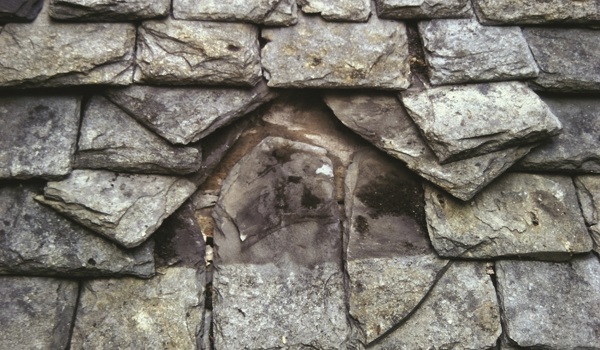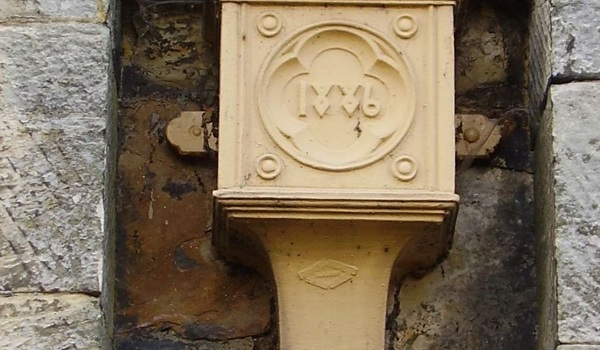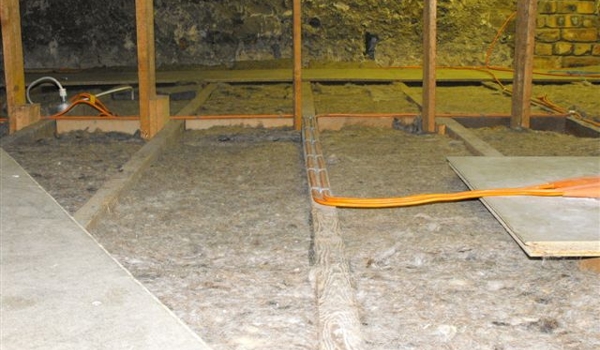Slate
Overview
Overview
Slate is one of the most widely used building materials in Scotland. It is particularly well known for its use as a roof covering on many traditional Scottish buildings. Slate has been used for this purpose for centuries.
Scottish slate has a well-earned reputation as a long-lasting material. But slate from some areas is much more durable than slate from other locales. Research has found that two main factors affect slate’s durability: its mineral composition and its crystallinity.
It’s wise to regularly inspect any areas of slate on a building to spot potential problems as soon as they appear. You should also make it a rule to check a slate roof, which is especially vulnerable, after any storms or gales.
Regular maintenance and repairs of a slate roof should be relatively inexpensive. Keeping on top of repairs will ensure that the roof stays watertight and performs well. The occasional replacement of a handful of slates is usually all that’s needed. Annual checks and replacements are usually about £200 – £300.
Scotland has a long history of slate quarrying. There were at least 80 slate quarries at one time. Ballachulish, Scotland’s largest slate quarry, had an annual output of 25 million slates by the mid-1800s. But the industry had dwindled by the early 20th century.
Looking after slate is all the more important since the material hasn’t been quarried in Scotland since the 1950s. Supplies for replacement purposes are very limited and so it’s best to reuse slates wherever possible.
Update your personalised ad preferences to view content
- Next
-
Characteristics
Characteristics
Characteristics
Slate is one of the most widely used building materials in Scotland. It is particularly well known for its use as a roof covering on many traditional Scottish buildings. Slate has been used for this purpose for centuries.
Recent research supports Scottish slate’s reputation as a long-lasting material: many slates are in service for 150 years or more. Often slate outlasts other elements of a building. Regular repair and maintenance to their fixings and support is vital for a long lifespan.
Scotland’s geology has produced a form of slate that is:
- relatively thick
- dark in tone
- rough to the touch
- remarkably durable
- variable in size
Slates from other parts of the world are usually much thinner and more regular in size. They also have smoother textures and different tones, which means that getting a match with older Scottish slate is difficult.
Find out more about slate roofs.
Geology
‘Slate’ was once a generic term used to describe any stone used for roofing. Sandstone was initially the preferred material, but schists and shale slates were also used. True slate was the main type of slate used by the 1820s.
True slate splits easily into thin sheets along its ‘slaty cleavage’, while other materials split along bedding planes.
Slate began life as fine-grained muds or silts, which over thousands of years became sedimentary rock. As the rock’s layers built up, the beds were compressed under the great weight to form shales.
High temperatures and movement in the Earth’s crust folded the rock and created a grain of white mica and chlorite from the clay minerals. These folds overlapped like fish scales to give the rock its slaty cleavage and incredible strength.
Learn more about the durability of slate.
Physical properties and appearance
Slate contains:
- micas
- chlorites
- varying amounts of quartz
- iron ores, calcite, magnesite and graphite in small quantities
As a composite material formed in various conditions, slate also varies widely in how it looks and performs. But as long as slaty cleavage is present, the slate will make a good roofing material.
The size of slates that a quarry could supply was also affected by the folding of the rock. The spacing of the fractures formed during this process, and the angle at which they crossed the cleavage plane, set the typical slate size. More wastage would result if larger slates were produced, while a smaller slate size made the most of the available material.
The variable size of Scottish slates led to the distinctive roofing technique known as ‘diminishing courses’. Larger slates were laid at the base of the roof and smaller ones at the top, to make best use of all of the slate quarried.
- Previous
-
Overview
- Next
-
Durability
Durability
Durability
Scottish slate has a well-earned reputation as a long-lasting material. But slate from some areas is much more durable than slate from other locales.
Research involving the experimental weathering of slates has found that two main factors affect slate’s durability.
Main factors affecting slate’s durability:
- mineral composition
- crystallinity
Mineral composition
The mineralogy of the slate is the main factor that gives slate its properties and relates loosely to its durability. High levels of quartz and a high ratio of white mica to chlorite correlate with long service.
The high levels of quartz in Ballachulish slate may account for its long life. In contrast, some Aberfoyle slate is known to soften after 20 to 30 years, and this may be because some seams have low quartz levels. (The presence of calcite may also be responsible.)
Minor minerals can exert a major effect on the durability of slate. Carbonates generally have a negative effect on durability, though the type of carbonate is important. For example, dolomite is much more stable (and thus has a more positive effect) than calcite.
Crystallinity
The metamorphic grade of slate, which controls crystallinity and affects grain size, is the next most important factor in determining the properties of slate.
Samples of weathered Ballachulish and Easdale slates, which are known for their durability, were found to have high to very high crystallinity.
Low water absorption typically indicates high durability, and more crystalline slates absorb less water. Any minerals present that might have a negative effect are also in a stable, crystalline form and so don’t lessen durability.
The negative effects of high water absorption are much reduced when minerals are in their oxidised form. In such slates, like Macduff slate, the minerals remain stable even if water gets into the slate.
- Previous
-
Characteristics
- Next
-
Inspection
Inspection
Inspection
It’s wise to regularly check any areas of slate on a building to spot potential problems as soon as they appear. You should also make it a rule to check a slate roof, which is especially vulnerable, after any storms or gales. Look up at the roof for damaged or missing slates, and down on the ground below too.
Tackling problems before they get worse will keep repair costs down. Looking after slate is all the more important since slate hasn’t been quarried in Scotland since the 1950s. Supplies for replacement purposes are very limited and it’s best to reuse slates wherever possible.
Like all natural materials, some Scottish slates can undergo changes that make them more likely to break. Your roofing contractor can test for this change by holding a loose single slate at its edge and gently tapping it in the centre with a hammer. A sound slate will ring out clearly, while a porous slate will produce a dull sound. Slates that are no longer good should be replaced.
Slates may also break due to:
- being lifted by the wind
- nails driven in too far – the slate is held too firmly against the sarking
- nails not driven far enough into the sarking – their heads stand proud, which may damage slates in the rows above
Find out about factors affecting the durability of slate.
Learn about inspecting a slate roof.
- Previous
-
Durability
- Next
-
Maintenance and repairs
Maintenance and repairs
Maintenance and repairs
Scottish slates are well known for giving long service. But their fixings and support must be well maintained to achieve this – particularly on a roof, which is constantly exposed to the elements.
Regular maintenance of a slate roof should be relatively inexpensive. Keeping on top of repairs will ensure that the roof stays watertight and performs well. The occasional replacement of a handful of slates is usually all that’s needed.
It’s best to reuse slates wherever possible. Slate hasn’t been quarried in Scotland since the 1950s, so supplies of slate for replacement purposes are becoming very scarce.
Slates from other countries are used in repairs, though not all imported slates match Scottish slate in looks or quality. If you can’t source second-hand local slates, choose a supplier that offers slate in sizes and textures more suited to Scotland’s roofscapes. Some slate from Wales and West Morland has been successfully used in repairs.
Any replacement slates must be selected carefully.
Pay close attention to:
- size
- texture
- thickness
- weight
- colour
A replacement that’s slightly lighter in colour will blend in better than a darker slate if an exact match can’t be found.
Find out more about the maintenance and repair of slate roofs.
- Previous
-
Inspection
- Next
-
Permissions for work
Permissions for work
Permissions for work
If you’re planning to do major reslating work, you should check whether you must first apply for planning permission or any other type of consent. Listed building consent or conservation area consent may be needed, depending on the property and its location. Contact your planning authority to find out more.
Care should be taken when removing the existing slate from the roof. Minimising breakages will allow for more of these slates to be reused. If a large quantity of new slate is required, you should seek the advice of your planning authority on the most appropriate material to use for re-roofing.
A record should be made of the existing roof covering before it’s dismantled, to allow replacement slates to replicate the original pattern.
Find out more about listed building consent and conservation area consent.
- Previous
-
Maintenance and repairs
- Next
-
History
History
History
Slate roofs really came into their own in the 19th century. The skylines we still enjoy today feature many designs that were created at this time, often involving steep pitches, intricate shapes and even turrets.
Around 1800, better woodcutting techniques made it possible to mechanically saw timber into thin boards to cover structural roof timbers. This ‘sarking’ allowed slates of different sizes to each be secured to a roof using a single nail. Previously, slates had been hung on timber battens using wooden pegs.
Also during the 19th century, slates were trimmed into scalloped and diamond shapes before fixing. With careful sizing, these individual pieces were combined to create complex architectural patterns across entire roof surfaces.
Slate production
‘Slate’ was once a generic term used to describe any stone used for roofing. Sandstone was initially the preferred material, but schists and shale slates were also used. True slate was the main type of slate used by the 1820s, as a result of its quality, durability and abundance.
Scotland has a long history of slate quarrying. There were at least 80 slate quarries at one time – most were tied to crofting and fewer than 30 were commercial.
By the early 1800s, the Scottish slate industry focused mainly on:
- the islands of Easdale, Seil, Luing and Belnahua
- Ballachulish, on the shores of Loch Leven
- the Southern Highlands close to the Highland Boundary Fault
- the Macduff and Foundland quarries of the north east
Each roof slope covered in slate bears the mark of the quarry that supplied the material. The exact pattern in which the slates are laid, and their colour and textures are all highly distinctive. This means it’s possible to spot neighbouring buildings roofed with material from the same source.
Peaks and troughs
Ballachulish would become Scotland’s largest slate quarry. It was producing an astonishing 25 million slates per year by the mid-1800s.
During a peak in 1895, Scottish quarries together turned out 45,000 tons of slates – around 8% of the UK total. By 1914, their combined output had dropped to just 8,000 tons.
Scotland’s slate industry dwindled due to:
- high costs
- lack of investment
- labour shortages
- competition from imported slates and concrete tiles
There were a couple of attempts to export Scottish slate across the border. But the rest of the British Isles preferred regular sized slates. Scottish quarries, which weren’t nearly as mechanised as those in England and Wales, didn’t have the means to deliver and sort regular sizes.
Scotland no longer has any slate quarries in operation. The Macduff and Foundland quarries closed first, around 1870. The rest had followed suit by the mid-1950s. Only recycled Scottish slate is available today, but the strength of the second-hand market testifies to the material’s merits.
- Previous
-
Permissions for work
- Next
-
Contacts
Contacts
Contacts
Get in touch if you have any questions. We will be happy to help.
- Technical Research Team
- 0131 668 8951
- technicalresearch@hes.scot
- Previous
-
History
- Next
-
Resources
Resources
Resources
Professional institutions
Stone Federation, Great Britain
The National Federation of Roofing Contractors
Confederation of Roofing Contractors
The Institute of Roofing
Publications
Inform guides
An introduction to conservation and maintenance of traditional buildings for complete beginners.
Repairing Scottish Slate Roofs
Research reports
Detailed reports of research carried out by Historic Environment Scotland on a variety of building conservation topics.
Macduff Slate – Extraction and testing of Slate from Hill of Foundland, Aberdeenshire
Scottish Roofing Slate – Characteristics and Tests
The Pattern of Scottish Roofing
Technical Advice Notes
In-depth technical information for building conservation professionals.
Other resources
Building Scotland – Celebrating Scotland’s Traditional Building Materials
The Building Conservation Directory
- Previous
-
Contacts





